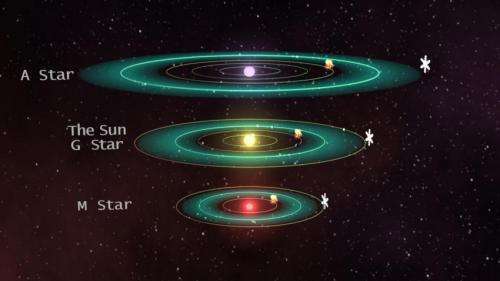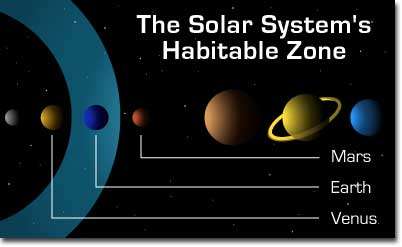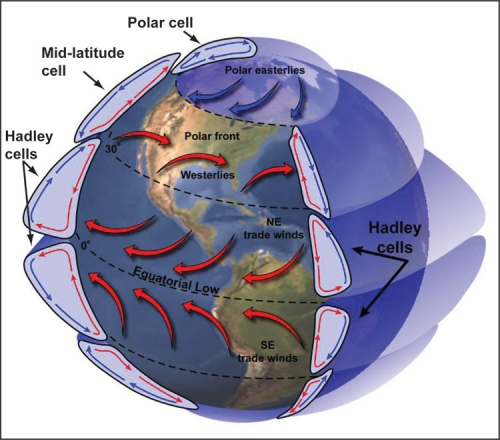Rotation of planets influences habitability

There are currently almost 2,000 extrasolar planets known to us, but most are inhospitable gas giants. Thanks to NASA's Kepler mission, a handful of smaller, rockier planets have been discovered within the habitable zones of their stars that could provide a niche for alien life.
The habitable zone of a star is typically defined as the range from a star where temperatures would allow liquid water to exist on the surface of a planet. At the inner edge of this zone, the star's blistering heat vaporizes the planet's water into the atmosphere in a runaway greenhouse effect. At the outer edge of the habitable zone, temperatures are so cold that clouds of carbon dioxide form and the little solar energy that does arrive bounces off the clouds, turning the planet into a frozen wasteland.
However, this concept is rather simple. In reality, many other factors come into play that could affect a planet's habitability. New research has revealed that the rate at which a planet spins is instrumental in its ability to support life. Not only does rotation control the length of day and night, it can also tug on the winds that blow through the atmosphere and ultimately influence cloud formation.
The paper has been accepted to Astrophysical Journal Letters and a preprint is available online at Arxiv.
Air circulation and rotation rates
The radiation that the Earth receives from the Sun is strongest at the equator. The air in this region is heated until it rises up through the atmosphere and heads towards the poles of the planet where it subsequently cools. This cool air falls through the atmosphere and is ushered back towards the equator. This process of atmospheric circulation is known as a Hadley cell.
If a planet is rotating rapidly, the Hadley cells are confined to low latitudes and they are arranged into different bands that encircle the planet. Clouds become prominent at tropical regions, which are important for reflecting a proportion of the light back into space. However, for a planet in a tighter orbit around its star, the radiation received from the star is much more extreme.
This will decrease the temperature difference between the equator and the poles and ultimately weaken the Hadley cells. The result is fewer clouds at the tropical regions available to protect the planet from the intense heat, and the planet becomes uninhabitable.

If, on the other hand, the planet is a slow rotator, then the Hadley cells can expand to encompass the entire world. This is because the atmospheric circulation is enhanced due to the difference in temperature between the day and night side of the planet. The days and nights are very long, so that the half of the planet that is bathed in light from the star has plenty of time to soak up the Sun. In contrast, the night side of the planet is much cooler, as it has been shaded from the star for some time.
This difference in temperature is large enough to cause the warm air from the day side to flow to the night side, in a similar manner as opening a door on a cold day results in warm air fleeing from a room. The increased circulation causes more clouds to build up over the substellar point, which is the point on the planet where the star would be seen directly overhead, and where radiation is most intense. The clouds over the substellar point then create a shield for the ground below as most of the harmful radiation is reflected away.
The high albedo clouds can allow a planet to remain habitable even at levels of radiation that were previously thought to be too high, so that the inner edge of the habitable zone is pushed much closer to the star.
"Rotation can have a huge effect, and lots of planets that we previously thought were definitely not habitable now can be considered as candidates," says Dorian Abbot of the University of Chicago, and a co-author on the paper.
Earth in Venus' orbit
The study used computer simulations to show that a slowly rotating planet with the same atmospheric composition, mass, and radius of the Earth could potentially be habitable even at Venus' distance from the Sun. Under the typical boundaries of a habitable zone, Venus is situated closer to the Sun than the inner edge of the zone. In the study, the simulated planet received almost twice as much radiation as the actual Earth did, and yet the surface temperature was cool enough for life to thrive due to the shielding clouds.
Despite the slow rotation, Venus itself is actually a scorching hot planet with a atmosphere so dense that it would crush a person on the surface in seconds. This goes to show that just because a planet is rotating slowly does not automatically mean that it is habitable, rather it has the potential to be habitable if the right conditions exist.
For instance, it is possible that Venus used to spin much faster, giving shorter days than it has now. Venus' atmosphere is enriched with deuterium, which indicates that an ocean might have once been present. Such a rapid rotation rate on a planet so close to the Sun would have led to a runaway greenhouse effect and the loss of the oceans. By the time the rotation of the planet slowed to its current rate the damage was irreversible.

Finding the slow rotators
While it is difficult to measure planetary rotation rates, future observations by the James Webb Space Telescope might be able to measure rotation if the right conditions were present. The James Webb Space Telescope is an infrared telescope due to launch in 2018, and it is capable of measuring the level of heat emitted by exoplanets.
The telescope would be able to measure the heat emitted from any high albedo clouds that are formed over the substellar point. An unusually low temperature at what is expected to be the hottest location on the planet could indicate that the planet is a potentially habitable slow rotator.
"From space, Earth looks like it is between -70 and -50 degrees Celsius over large regions of the western tropical Pacific because of high clouds there, even though the surface is more like 30 degrees Celsius," says Abbot.

It is also known than many planets that orbit cool M dwarf stars are either tidally locked, meaning that the same side of the planet faces the star all the time, or they are slow rotators.
This research emphasises the importance of looking beyond the traditional habitable zone for planets that could host life, and it turns out that planets we once thought were too hot might actually be just right for life.
Journal information: Astrophysical Journal Letters , arXiv
Source: Astrobio.net
This story is republished courtesy of NASA's Astrobiology Magazine. Explore the Earth and beyond at www.astrobio.net .





















